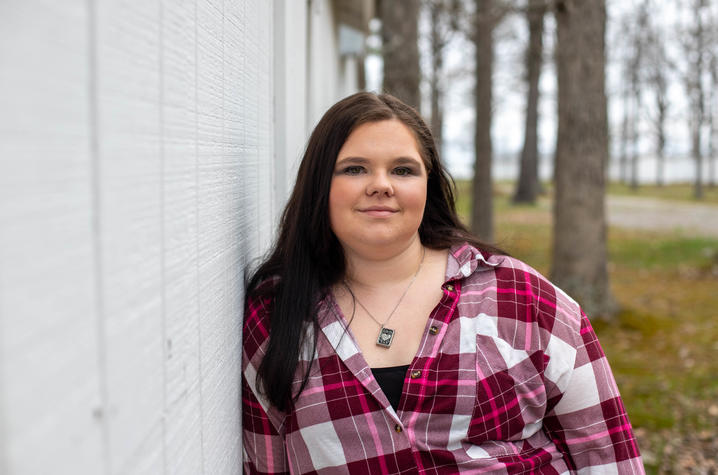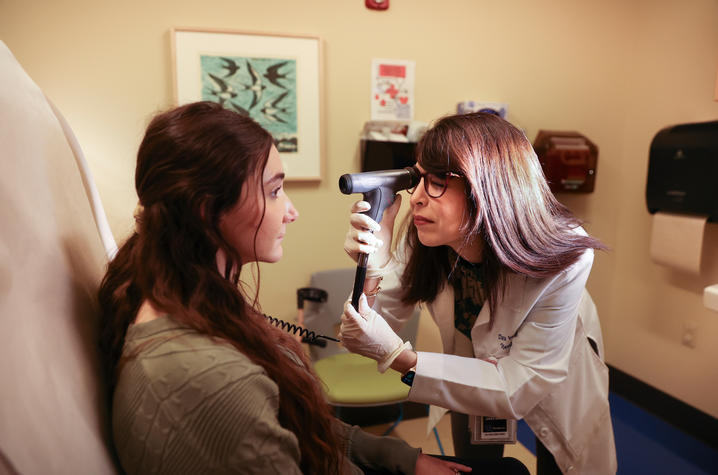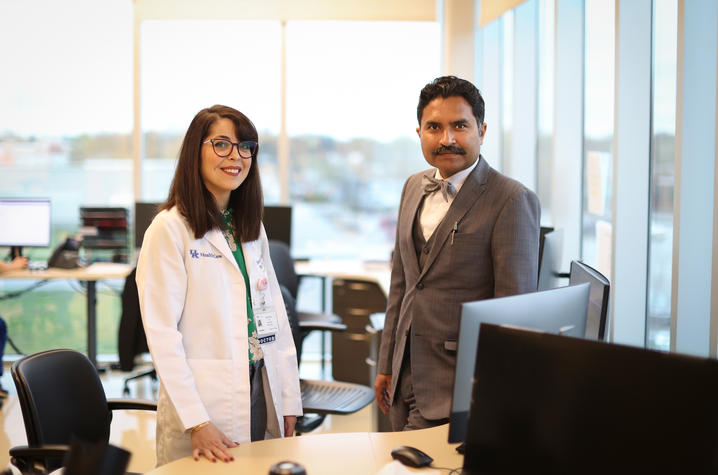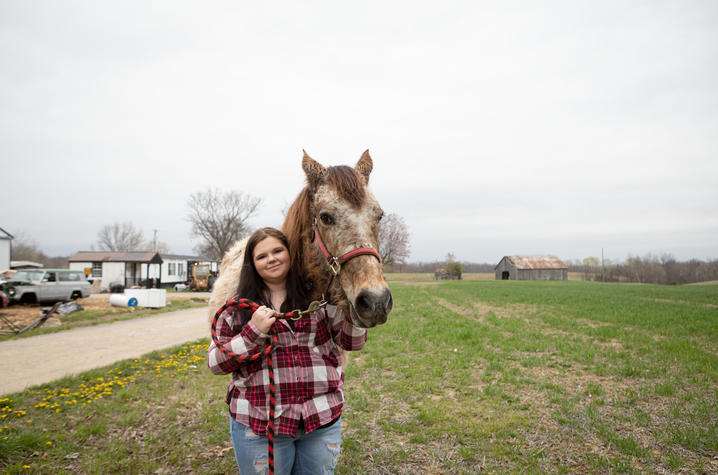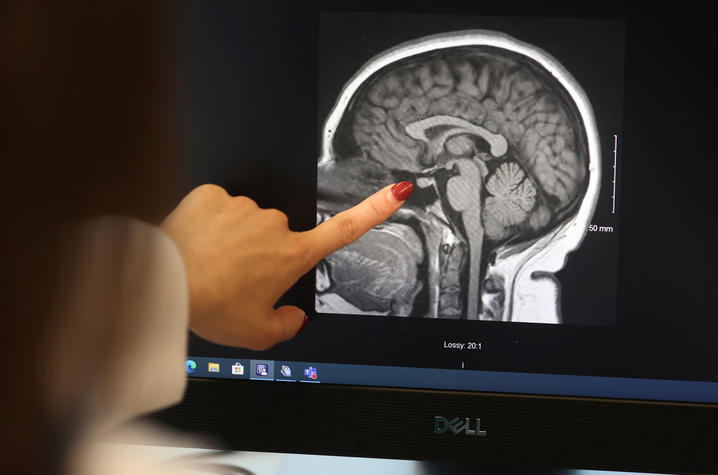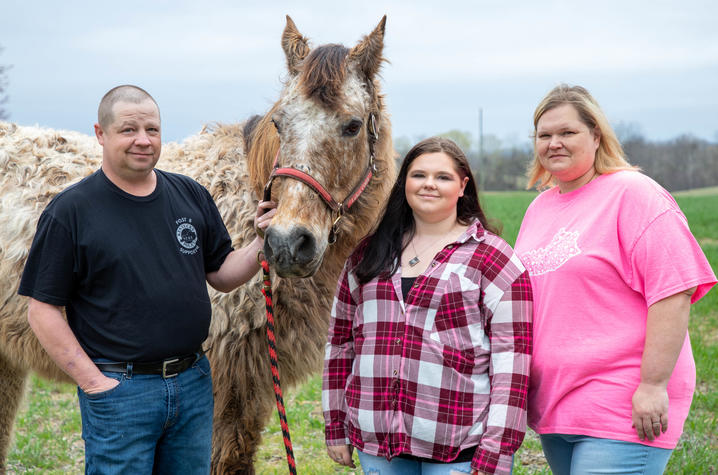‘They didn’t give up’ — UK child neurologists help teen navigate rare headache disorder
LEXINGTON, Ky. (April 20, 2023) — Brittany Smith knows a thing or two about headaches. The 17-year-old began experiencing migraines at the age of eight. However, in October 2019, the intensity of her headaches escalated and began wreaking havoc on her life.
“Her parents had to pull her out of school because she had missed so much,” said Dana Ionel, D.O., a headache fellow at UK HealthCare’s Kentucky Neuroscience Institute.
“She would just stay in bed. She would not come out of her room, and we would just keep going in there to check on her,” said Brittany’s mom, Tami Smith.
The headaches took on this different force just shy of Brittany’s 14th birthday. The first episode started with her face feeling a bit tight in the morning, and by the time she got home from school, her right eye was swollen and drooping.
“We thought maybe it was something with her eye, so we went to the eye doctor,” said Tami. “They were unsure what was going on, so we went to our local emergency department.”
Doctors there thought Brittany was potentially experiencing Bell’s Palsy, but suggested she go to the emergency department at the University of Kentucky Albert B. Chandler Hospital.
Brittany and her parents made the 90-minute drive from their home in Tollesboro to Lexington. Once at UK, doctors ruled out Bell’s Palsy and suspected it was connected to her migraines. Brittany was admitted and remained in the hospital for five days. During those five days, she underwent numerous tests, but her case proved to be tough in finding definitive answers.
Brittany’s episodes continued and intensified. Each time she would experience a debilitating headache that occurred only on her right side, along with swelling and drooping of her right eyelid. Watching their daughter suffer, Tami and George Smith tirelessly sought answers. Brittany underwent more testing by more doctors, including tests to check for seizures.
“We have been through the wringer with so many different doctors, and nobody had a clue what it was. We just kept hearing complicated migraines or cluster migraines,” said Tami. “Then we were told she would probably lose the use of the right side of her body and not just her face, but still we had no answers. It was just very frustrating.”
Tami and George both work as emergency medical technicians (EMTs). “It is nothing we’ve seen before and when I asked other medics that we work with, they’ve never seen it before either,” said Tami.
As they searched for answers, the frequency of Brittany’s headaches increased. They went from happening once or twice a month, then to once a week, and then to two or three episodes in a single week. She also endured rounds of harsh medications that would leave her with nausea, vomiting, and fatigue in the days that followed. It was hard on the teen who previously loved being outdoors and going to school.
“She had a tough time dealing with the differences,” said Tami. “People didn’t understand and would say things like ‘Oh, it’s just a headache’ or ‘Oh, it’s just a migraine.’ It was not just a migraine.”
Brittany’s parents saw the toll this experience was taking on their daughter, so they helped her begin counseling. Her providers also suggested she start taking medication for depression. The family was desperate for answers and desperate to see Brittany get back to enjoying life.
Shortly after settling into what they thought was their new normal, Brittany received a referral to UK’s Children and Young Adult Headache and Research Program, where she met Dr. Ionel.
“I did not think she had complicated migraines given the failure of all the medications and description of pain,” said Dr. Ionel. “I thought instead that she likely had trigeminal autonomic cephalgia (TAC).”
TACs are a subgroup of headache disorders that include cluster headaches, hemicrania continua, paroxysmal hemicrania, and short unilateral neuralgiform headache attacks (SUNA/SUNCT). They are one-sided headaches that typically include what are called autonomic features on the same side of the headache - some examples are a bloodshot eye, drooping of the eyelid, swelling of the eyelid, a small pupil, and either excessive runniness or stuffiness of the nose. These symptoms can sometimes be confused for Bell's palsy or even a stroke. These symptoms come with the headaches, and typically go away as the headaches are being treated.
According to doctors, TACs are very rare, and even more so rare in children. The specific TAC Brittany was experiencing is known as hemicrania continua.
“For reference, hemicrania continua is thought to represent about 1.7% of all headache disorders,” said Ionel. “It is so rare that a prevalence in the general population cannot be determined.”
Ionel says that TACs are often not recognized and are extremely underdiagnosed. “They have a big burden of disease. Education of these disorders is so important because they can mimic migraines and other conditions which are much more common,” she said.
Following her suspicions about what was going on, Ionel started Brittany on a medication that is only used for TACs. It helps to not only treat the symptoms, but also diagnose the patient. Thankfully, it worked.
“She had resolution of the headache and the facial symptoms,” said Ionel.
After three years, the Smiths finally received an answer and a treatment that gave Brittany her life back.
“She has not had an episode since we got the diagnosis and started medication in December of 2022,” said Tami. “She doesn’t have to take her depression medicine anymore. She is back to her happy self, just like she was before this all started.”
Brittany also recently obtained her high school degree through an online program – a year ahead of schedule. She’s enjoying doing all the teenage things she was unable to do before, like driving a car. Brittany is thrilled to be back to enjoying time outdoors with her horse, Buttercup, and working hard at her job at a local restaurant.
“It is just amazing. She’s not just in her room all the time,” said Tami.
The Smiths are thankful for Dr. Ionel and all the others at UK Child Neurology who helped them on this long road to an answer. At that first visit, Ionel and others were unable to determine which specific trigeminal Brittany had.
“She kept researching and researching until she came up with the answer to which one Brittany had, which was hemicrania continua,” Tami said. “If she wasn’t calling us to check in, she was sending us messages through our online portal … she was just constantly checking on Brittany.”
That communication and genuine care have continued as Brittany and her family start a new chapter with a TAC diagnosis. It is a diagnosis they are thankful to now know and understand.
“We cannot thank Dr. Ionel and UK HealthCare enough. We were desperate, and they didn’t give up,” said Tami.
UK HealthCare is the hospitals and clinics of the University of Kentucky. But it is so much more. It is more than 10,000 dedicated health care professionals committed to providing advanced subspecialty care for the most critically injured and ill patients from the Commonwealth and beyond. It also is the home of the state’s only National Cancer Institute (NCI)-designated Comprehensive Cancer Center, a Level IV Neonatal Intensive Care Unit that cares for the tiniest and sickest newborns and the region’s only Level 1 trauma center.
As an academic research institution, we are continuously pursuing the next generation of cures, treatments, protocols and policies. Our discoveries have the potential to change what’s medically possible within our lifetimes. Our educators and thought leaders are transforming the health care landscape as our six health professions colleges teach the next generation of doctors, nurses, pharmacists and other health care professionals, spreading the highest standards of care. UK HealthCare is the power of advanced medicine committed to creating a healthier Kentucky, now and for generations to come.





